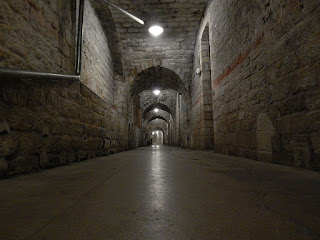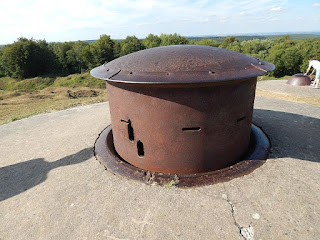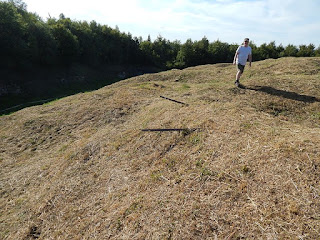Following on from the earlier post.
Again I awoke early, but this time James was awake too so leaving Nick to his snores we set off to explore the Vauban fortress that I had found a few minutes walk from our campsite.
This time we are having a proper explore and decide to do a circuit. Just by the works I had found yesterday was the entrance that must have been the first view our troops in 1916 had of Verdun after travelling down Voie Sacrée from Bar-le-Duc.
Just to the left of this is one of the outlying bastions or ravelins. This entrance led to a stairway up to the top. I did not fancy stumbling around in the dark so instead took the external route to this vantage point.
After coming back down to level ground James and I started out circuit of the citadel.
It is remarkably well preserved having been built between the 1670's and was still being added to in the Napoleonic wars. Verdun was the last French fortress to surrender in the 1870 Franco-Prussian war, and as Alsace-Lorraine was carved up after that it was a bastion on the frontier between France and Germany.
The walls stand approximately 12m high but tower above you when you are stood in the ditch. In some places trees have taken root in the stonework and the damage they cause is quite evident.
During the 1916 Battle of Verdun many French troops were stationed here in the 4km of subterranean tunnels and the bakery produced 28,000 bread rations per day.
This gate seems to be a newer part of the fort, maybe a early 19th century addition.
Completing our circuit of the fort we headed into Verdun proper for breakfast. Say what you like about the lack of paper in their public toilets and their laissez faire attitude to customer service, but the French do have this, a pizza dispensing vending machine!
Carrying on into town James and I pick up croissants and pain au chocolat to take back to the campsite for breakfast. We then climb the steps to the Verdun Victory Monument and enjoy the views over the town.
We then grab a coffee and some gifts at another lovely patisserie and it's back to the campsite to break camp, load the car and set out for our first sight-seeing location of the day at Fleury-devant-Douaumont.
During the battle the small town was captured and recaptured 16 times and completely destroyed in the process. Only smears of rubble from the former buildings could be seen among the hollows and depressions of former cellars and shell holes.
In the 1960s several marker posts were added to show what premises were housed at each sad location
Leaving Fleury-devant-Douaumont we drove up the hill to the sombre Douaumont Ossuary. Here, the remains of 130,000 unidentified combatants from the battlefield are interred. Over the 300 days of the Battle of Verdun over 230,000 died from a terrible 700,000 dead wounded or missing. Approaching the building from the rear you can gaze through the windows into the chambers piled with the skeletal remains of these unfortunates. Inside the building the knave is decorated with plaques commemorating some of the dead along with the departments of France.
We then climb up the 46m high bell tower and get fantastic panoramic views of the battlefield. You can also see outside the largest military cemetery in France with over 16,000 graves.
It was then back to the car for the next short hop. Having been our faithful servant for the weekend, it is only fair that my Mini gets a picture in this blog so here it is in the car park at the Ossuary looking rather like a BMW promotional photo.
We travel back along the ridge to Ouvrage de Froideterre. This is not one of the famous forts like Douaumont, Vaux or Souville but was rather a high watermark for the Germans in 1916, they got on top of the works without realising it but it remained in French hands.
We scramble on to the roof and are soon examining a very well preserved twin 75mm turret and two machine-gun turrets.
Making our way to teh western edge we find a very well preserved Bourges casemate.
Working our way back around the fort we find this. I am pretty sure I know what the sign says (OK I admit it I know exactly what the sign says) but the gate is open and it is so tempting!
Inside is the remains of some accommodation.
But further along a corridor into the bowels of the fort we locate the steps up to one of the machine-gun turrets. Given the age and the action seen it is very well preserved although I would advise that you stand on the ironwork rather than the woodwork.
This is the counter-weight for raising and lowering the turret.
I then move to the eastern edge of the fort and have a quick look around the barrack block including, as seems to be usual for this trip, a quick look at the latrines.
We could have spent hours investigating l' Ouvrage de Froideterre however time is cracking on and we have a long journey back to Calais and there is still one 'must see' sight left.
We travel about 9km along the roads to the Bois Des Caures to visit the sight of one of the opening clashes of the conflict. This has quite some meaning to myself and James as our ongoing Chain of Command campaign features a series of games based on these actions.
As we enter the woods we feel quite vindicated in how we have laid out our games as these are the current hazel trees and you could imagine what they looked like after a days intense bombardment in February 1916.
Following the path we first come to Colonel Driants command post where we spend quite some time taking photos.
There are some serious shell holes, this one is almost 100 years old and is still very deep.
You eventually arrive back at the main road next to the memorial to Colonel Driant and his Chasseurs killed defending Bois Des Caures on 21st / 22nd February 1916.
Crossing the road we follow the path some more and locate Driants original grave and the place where he fell.
It was now time to grab a picnic lunch and head back up to Calais for the shuttle home. Again, despite the reports from both the press and government there was no disruption to our journey.
I did the first leg, but after only about 100km Nick took over and drove us all the way back and took us all the way through to Nottingham.
It really is a great trip and although we saw everything we had on our hit list in the two days we had assigned I reckon we could easily have spent a couple of weeks exploring the battlefield and it's environs.
As you can see from the photos the weather remained lovely for the trip.
I hope you enjoyed my little report, although at about 3500 words between the two posts it's probably a bit much. I took oner 400 photos and James took a similar amount, if you want to see those let me know and I can share them with you via OneDrive.





































































































